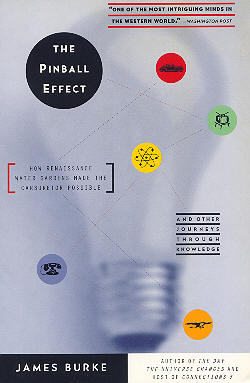The Pinball Effect
James Burke

In a departure from the fiction which has been reviewed in previous issues of the Newswire, we turn this month to a recent work by James Burke, titled The Pinball Effect. This is nonfiction of the best sort, engaging and well-written, without being overblown or tedious. Burke is the author of several books dealing with the history and development of technology, and the host of the television series Connections 3, which airs on The Learning Channel.
In The Pinball Effect (subtitled How Renaissance Water Gardens Made the Carburetor Possible), Burke draws on his years of research to examine the surprises and intrigue on a journey through knowledge, a trip holding all the twists and turns of a mystery story. The picture that emerges from all this has far-reaching implications for the future, and reveals why the fundamental mechanism of change is the unplanned way that ideas come together. The “pinball effect” of history is recreated in the book by the use of cross-chapter references, which allow readers to leap easily from one related discovery to another. Consider this brief excerpt from the chapter ‘High Time’:
“Much of modern technology is so pervasive that it often goes entirely unnoticed. People speak of “transparency” when describing information systems that interact with others as easily as if there were nothing between them. The goal is to make innovations so “user-friendly” that most of the time we’re unaware of their presence. Plastic wrap is perhaps one of the best examples. It is essential, pervasive, easy to use and (literally) transparent. And like almost every other piece of technology, anywhere and anytime, it came into existence by accident.
Plastic wrap first came to general attention early in World War II. At the time, German bombers were conducting nighttime raids against England almost at will. What little opposition the Germans encountered would be a few fighters vectored against them by controllers working under the considerable limitations of the early-warning radar of the time. So warning was not very early. In addition, the radar, which was positioned along the south and east coasts of England, used long-wavelength signals requiring large aerials that were an easy target. Therefore, the British were keen to find ways of transmitting radar signals from smaller aerials. Either that, or the war was going to be over almost as soon as it started.”
Burke goes on to relate how this particular problem was solved, along with a host of others, all amazingly interconnected. The entire book is a fascinating tour through some of history’s most dramatic and revolutionary innovations - be sure to read all about it!
All Rights Reserved.